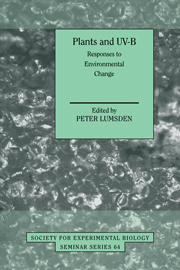Book contents
- Frontmatter
- Contents
- List of contributors
- Preface
- PART I The ozone layer and UV-B radiation
- PART II Effects of UV-B on plants at the cellular level
- PART III Effects of UV-B at the whole plant and community level
- Effects of solar UV-B radiation on aquatic ecosystems
- Assessing the impact of UV-B radiation on the growth and yield of field crops
- Effects of UV-B radiation on plants from agro- and natural ecosystems
- Effects on subarctic vegetation of enhanced UV-B radiation
- Impacts of elevated UV-B on forest ecosystems
- Effects of elevated UV-B radiation and elevated CO2 on heathland communities
- Alterations in competitive balance
- Interations between trophic levels
- Index
Effects of UV-B radiation on plants from agro- and natural ecosystems
Published online by Cambridge University Press: 04 August 2010
- Frontmatter
- Contents
- List of contributors
- Preface
- PART I The ozone layer and UV-B radiation
- PART II Effects of UV-B on plants at the cellular level
- PART III Effects of UV-B at the whole plant and community level
- Effects of solar UV-B radiation on aquatic ecosystems
- Assessing the impact of UV-B radiation on the growth and yield of field crops
- Effects of UV-B radiation on plants from agro- and natural ecosystems
- Effects on subarctic vegetation of enhanced UV-B radiation
- Impacts of elevated UV-B on forest ecosystems
- Effects of elevated UV-B radiation and elevated CO2 on heathland communities
- Alterations in competitive balance
- Interations between trophic levels
- Index
Summary
Introduction
Most reports on effects of enhanced UV-B radiation on terrestrial plants relate to agricultural crops cultivated under laboratory, climate room or greenhouse conditions (Caldwell & Flint, 1994a). Many early studies reported differential growth reduction and a decrease in yield of crops, mostly from temperate climate regions. In reviews by Caldwell, Terramura & Tevini (1989) and Caldwell and Flint (1994b), direct damage effects were stressed. Reduced plant growth under enhanced UV-B was expressed as a reduction of plant height, plant dry weight and leaf area. Also, photosynthetic activity was reported to be reduced under enhanced UV-B radiation, through direct effects on the photosynthetic process (photosystem II, in particular) or indirectly by effects of UV-B radiation on photosynthetic pigments or stomatal functioning. Sensitivity to enhanced UV-B was shown to vary among plant species and cultivars of a crop species.
Fewer studies have been made of UV-B effects on native plant species in their natural ecosystems. Where these have been carried out, negative effects of enhanced UV-B radiation, simulating realistic scenarios of stratospheric ozone depletion, tend to be less than predicted from greenhouse studies (see chapter by Corlett et al., this volume). Rather than direct effects of enhanced solar UV-B radiation, indirect UV-B effects may change structure and functioning of agro-ecosystems and natural ecosystems. This chapter considers the effects of enhanced UV-B radiation on plants from agro-ecosystems and natural ecosystems.
- Type
- Chapter
- Information
- Plants and UV-BResponses to Environmental Change, pp. 213 - 232Publisher: Cambridge University PressPrint publication year: 1997
- 20
- Cited by



